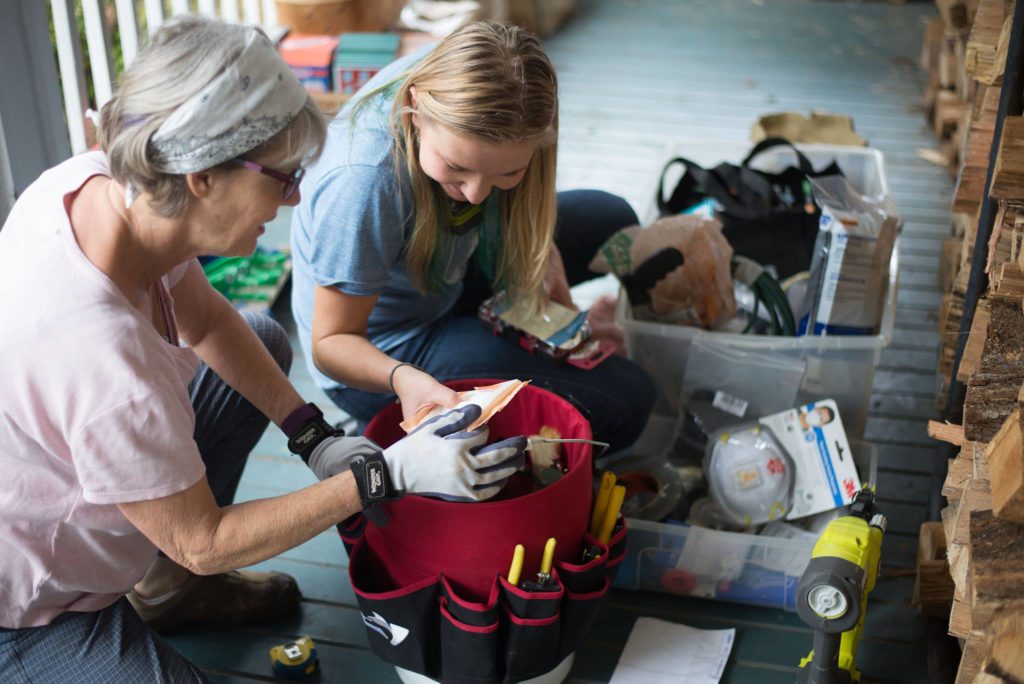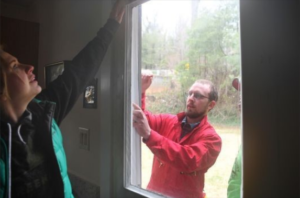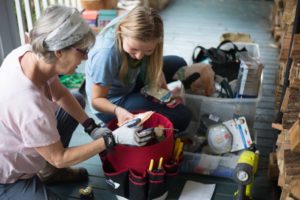Reducing Peak Energy Demand in Buncombe County, NC

On cold winter mornings in Buncombe County, North Carolina, Tracy used to wake up to a difficult choice: try to heat her Asheville home and face an impossibly high utility bill, or ignore frozen fingers and toes so she could afford to feed her two small children.
Tracy isn’t alone. Peak demand in the county during the colder months has more than doubled in the past several decades as the population has grown, and many of those energy users are low-income families that struggle with the cost of heating.
To meet the spike in demand the local utility, Duke Energy, proposed construction of a natural gas-fired “peaker” plant, but Asheville and Buncombe County residents pushed back against the idea. The City of Asheville and Buncombe County have adopted an ambitious energy goal: to be powered by 100% renewable energy for all government operations by 2030, and for all homes and businesses by 2040. To reach this goal — and to eliminate the need for a peaker plant — the area not only must work toward renewable energy production, it also must reduce energy demand.

The city and county governments entered into an unprecedented partnership with Duke Energy to find a different, more sustainable solution. Together, they created an Energy Innovation Task Force (EITF) in 2016, which in turn created the Blue Horizons Project in 2017 — an effort with a clear near-term goal of reducing energy demand, and a longer-term goal of moving to 100% renewable energy. An energy analysis conducted by the Rocky Mountain Institute at the behest of the EITF revealed the potential for dramatically reducing energy consumption in low-income households — and driving down residents’ energy costs — by making homes more energy efficient.
“Our short- and long-term energy goals are important, but we also want it to produce other community benefits like reduction of utility bills for lower income individuals and families and making them more comfortable and healthy in their homes,” says County Commission Chairman Brownie Newman. “Directly tackling home energy efficiency helps offset peak demand and also directly helps address high utility costs for families. It checks a lot of different boxes in terms of what we’re hoping to accomplish.”
“…We also want it to produce benefits like reduction of utility bills for lower income individuals and families and making them more comfortable and healthy in their homes.”
— Brownie Newman, Buncombe County Commission Chairman
It may ultimately help the county’s budget as well. Buncombe County spends nearly $2 million each year in emergency heating assistance.
“Energy inefficient housing is already very expensive for taxpayers because we’re investing money to address the critical heating needs of low-income families who struggle with utility bills,” says Newman. “This program won’t eliminate that need in the short term, but it could save us millions down the road.”
Although the Blue Horizons Project is wide-ranging and long-term, the element of immediate energy reduction in low-income homes aligned perfectly with a grant opportunity from the Southeast Sustainable Communities Fund (SSCF), a program of the Southeast Sustainability Directors Network, The Kendeda Fund, and The Kresge Foundation, with support from Merck Family Fund. The city, county and utility applied together and received $300,000 to help make area homes more efficient, warmer, and healthier for those who live in them. In some cases, this can be accomplished by relatively simple weatherization and efficiency upgrades. In others, a full energy upgrade is required, including new heating equipment or more substantial solutions.
Leveraging Local Partners
Of course, providing energy efficiency upgrades takes manpower, and neither city nor county had the staffing to do it. Instead, they reached out to area nonprofit partners who were already familiar with and performing these services in community. The Green Built Alliance, a local nonprofit dedicated to advancing sustainability, serves as the program’s coordinating arm, and the city and county share the cost of a full-time coordinator’s salary. One huge benefit of this approach is the ability to align the multiple partners that are part of the city and county’s energy efficiency landscape.
“We had a lot of services available in the community, but none of them were really working together,” says Jeremiah LeRoy, Buncombe County’s Sustainability Officer. “They weren’t talking to each other, referring to each other, or doing anything to fill the gaps. So we developed a centralized process where people can get the information they need about the services available and figure out if they qualify and how to proceed.”

A coordinator at Green Built Alliance works with a number of other agencies to locate homes in need of energy upgrades, and to provide the volunteer labor and resources to make them. For example, Eblen Charities, which is the area’s leading source of heating bill assistance, provides information about the free weatherization and upgrade opportunities. Community Action Opportunities provides the skilled labor for larger energy upfits or retrofits, and Energy Savers Network volunteers perform the simpler weatherization and home energy upgrades. The SSCF grant supports the purchase of materials needed for retrofits and upgrades, and project team members also leverage other funding from sources like the federal Low Income Home Energy Assistance Program (LIHEAP) or Weatherization Assistance Program (WAP).
The US Department of Energy estimates that of the $2,000 the average US household spends on energy annually, as much as $400 could be going to waste because of leaky doors and windows or outdated heating or cooling units. For low-income homeowners like Tracy, even seemingly simple weatherization can make a huge difference. When volunteers from Energy Savers Network visited her home, they caulked leaky seams, changed lightbulbs to low-energy LEDs, installed storm windows (made by the volunteers themselves), and insulated the hot water heater.
The Critical Role for Utilities
As members of EITF explored energy efficiency options, they also learned that far too few homeowners were taking advantage of Duke Energy’s available incentives for efficiency upgrades.
“When we were exploring our options early on, we realized that we didn’t have to create a new program,” says Asheville City Councilwoman Julie Mayfield. “Duke Energy had programs that were there and all we had to do was point people to them in a much more concentrated way than had happened in the past. It was just a matter of taking advantage of the infrastructure that was already there.”
Examining its role also led Duke Energy to make some changes as well.
The company is currently in the process of installing Advanced Metering Infrastructure, or “Smart Meters,” throughout the county that will help both the utility and homeowners better understand their energy usage. The utility has agreed to give priority to homes that participate in the energy efficiency upgrade program.
The company also worked with county and city staff to develop and receive approval for a new residential pay-for-performance program for low-income customers. The three-year pilot began January 2019.
“We have great partners at Duke Energy – we really do,” says Bridget Herring, Energy Program Coordinator at Asheville’s Office of Sustainability. “We would have gotten nowhere without them.”
Taking Time to Understand Buncombe Co.’s Community
Although the temptation was strong to start work immediately, the project team realized the importance of thinking the process through to better understand both the communities it would serve and the hurdles it might encounter. The Center for Social Inclusion and the Government Alliance for Racial Equity conducted a two-day equity training in Asheville and Buncombe Co. for all program partners, and the team has hired a local equity consultant to help maintain equity awareness and focus, and to facilitate a community advisory group.
“The advisory group is made of various neighborhood association members and folks in the community who will give us some honest feedback on not only the specifics about our program but how we do outreach,” says LeRoy. “Let’s be honest, the government’s never historically been good at addressing equity and so this group is designed specifically to provide us feedback on how we’re doing and how we can be kind of mindful of these things as we continue to develop this program. We’re finding out all the time that we need to adjust our strategies here and there.”
In addition, the team also had to work through the process of identifying and contacting homeowners who would benefit from the program. Privacy policies within the county prevented health and human services staff from disclosing the names of families that might need assistance, and although Duke Energy had the data about peak usage for each customer, its privacy policies prevented it from sharing that information with the city and county. Project team members had to develop a Utility Release Form and gain approval from Duke Energy’s legal department, a process that took some time.
“Data privacy is a challenge,” says Robert Sipes, Vice President of Western Carolinas Modernization for Duke Energy. “We are all trying to expedite things within bureaucracies that are actually in place to protect customers. That can present some significant hurdles and bottlenecks, and it requires us to be patient and persistent with one another. But we’ve built a lot of trust with one another over the past two-and-a-half years.”
Once homeowners are identified as good prospects for energy efficiency upgrades, there’s still convincing to be done.
“One of the challenges is that you’re dealing with people who are in constant crisis mode — you know, ‘I gotta pay the bill that’s in front of me today. Don’t talk to me about my power bill in January when it’s August,’” says LeRoy. “It’s hard to get their attention.”
Targeting those who apply for heating bill assistance through Eblen Charities emerged as a key strategy for making those connections when homeowners are feeling the economic pinch most acutely. The team also has created a single intake form that multiple agencies can use to connect homeowners to the energy upgrade services.
Another challenge is the condition of homes that are in need of energy upgrades. Often the buildings themselves are in dire need of repairs, mold mitigation, or other services before energy upgrades can begin. LeRoy and Herring have had to adjust their approach and work with nonprofit partners to add repair services to the mix.
“Fortunately, we have the flexibility in our funding to address some of those home repair and remediation issues,” says LeRoy.
All of this planning and troubleshooting took nearly a year, and was cause for impatience, but LeRoy says allowing for that time is a critical part of success. “Think about it. We’re a collective of government agencies and utility. Can you imagine trying to establish trust within communities that have no trust of government or utility? That is the biggest lesson we’re learning here: you just cannot force this stuff. It has to happen and it has to happen slowly. And you have to allow it to take its natural course.
”Now that plans and permissions are more concrete, members of the energy upgrade team have begun work and completed weatherization work, energy upgrades or full retrofits on 34 homes, with an eye toward many more in 2019.
“To some degree, your job as an elected official is to put the stake in the ground… That’s where elected officials have to be the voice and the vision.”
— Julie Mayfield, Co-Director of Mountain True and Asheville City Councilperson
“Our goal is to complete work on 100 homes this year,” says Herring. “We anticipate that about 30 of those will get a full home retrofit and the rest will receive more basic energy upgrades like weatherization.”
Lessons for Buncombe Co.’s Elected Leaders
As with any pilot program, the project partners are continuing to learn valuable lessons about doing this work. For elected leaders, that means having the courage to step out in front.
“To some degree, your job as an elected official is to put the stake in the ground, even if you don’t yet know exactly how you’re going to get there,” says Mayfield. “That’s where elected officials have to be the voice and the vision.”
Having the right data in hand is also essential, says Newman. “Doing quality professional assessments of all of your facilities, like we did with Rocky Mountain Institute, is like the most obvious thing in the world but so many people don’t factor in that step. And we couldn’t have done what we’ve done so far without the usage data from Duke Energy.”
“The people who are at the table matter tremendously,” Mayfield adds. “The first thing is that you’ve got to find the people who care and are really going to invest the time to build that partnership. You’ve got to have elected leadership at the city and county level, and willing councils and commissions to go along. Then there has to be staff that are committed, capable and willing to work together. I don’t think we could have done it if our city and county didn’t both have sustainability offices. And quite frankly, there’s no way we could make our long-term transition to renewable energy without the utility at the table as a full and willing partner. What we’ve developed here in Asheville and Buncombe County may not be unique, but it’s pretty special.
“It’s a win-win… Duke Energy now has a better business model, our customers will get the kind of energy they want at a price they want, and local economies can continue to be successful and vibrant.”
— Robert Sipes, Vice President of Western Carolinas Modernization for Duke Energy.
Although many sustainability offices are city-based, Newman sees an opportunity for more counties, such as Buncombe, to reap the benefits, especially when it comes to increasing the scale of sustainability efforts.
“I think there’s a little bit of a blind spot in the sustainability movement when it comes to counties. Counties like Buncombe cover a lot of territory, and we have a lot more public facilities in general than municipalities have. And have a lot of stuff. They have a lot more public facilities in general than municipalities have. I think we all need to be thinking bigger, because things are changing fast, and things that seemed impractical, idealistic, or not feasible not too long ago are rapidly becoming absolutely achievable. Sometimes doing a big project is more financially feasible than doing a small one.”
For Asheville and Buncombe County, the big vision begins with small actions –one home at a time. What’s more, it’s working. Duke Energy removed the peaker plan from its Integrated Resource Plan and is expanding solar production at its Asheville plant.
“It’s a win-win,” says Sipes. “Duke Energy now has a better business model, our customers will get the kind of energy they want at a price they want, and local economies can continue to be successful and vibrant. It always blows my mind how much you can accomplish when you choose to work together.”
Tracy’s home started feeling warmer before the volunteers had even finished their work. Now, when cold mornings come, the house no longer has a bone-chilling feel. It warms faster and holds that warmth better. Tracy also has learned other tricks for saving energy and lowering heating costs. She keeps the thermostat at a reasonable temperature and dons a sweater, then turns the thermostat down when she leaves for work. She looks forward to seeing the savings when her next utility bill arrives, but she also knows that her actions will benefit more than just her family. Her energy savings are helping to create a more sustainable community for everyone.
The Southeast Sustainable Communities Fund (SSCF) awards grants to local partnerships in the southeastern United States to advance local government policies and programs that will create equitable and sustainable energy and water initiatives. SSCF is a partnership between The Kendeda Fund, The Kresge Foundation and the Southeast Sustainability Directors Network (SSDN).
For more information please visit www.southeastsdn.org.
Contact: Meg Jamison, meg@southeastsdn.org
All images are used with permission from Buncombe County and the Energy Savers Network.